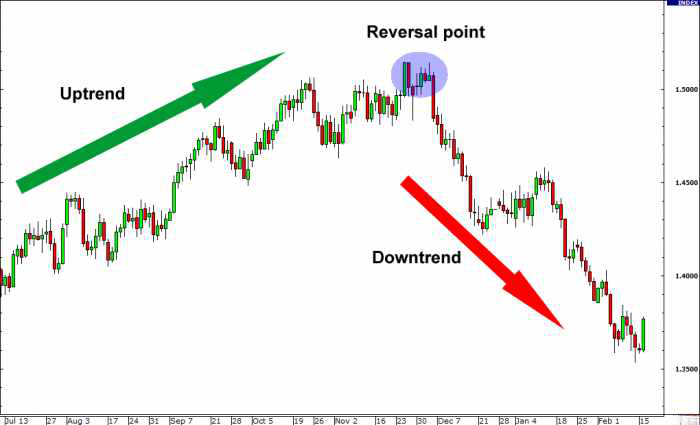The Trend Reversal Trading Strategy Guide
Do you make these mistakes in reversal trading?
Here’s the thing:
Trading trends can be a successful strategy for trading the markets. There are right and wrong ways to use this trading method, just as with any other.
Let me first explain how you SHOULD NOT do it before I show you how to do it correctly: market reversals are traded.
1. You’re catching a falling knife
To long the markets as they drop like a rock, known as “catching a falling knife,” for those unfamiliar.
It appears somewhat as follows:

I would say…
There is no need whatsoever to attempt to catch a falling knife.
Why?
Because there is no support or market structure you can use to place your stop loss, there is no logical place to do so.
Typically, the primary basis for determining your stop loss is the amount of equity still in your account. A sure way to lose it is to open an account.
This is something I discovered when I read this quote by Jesse Livermore… “Rome was not built in a day, and no real movement of importance ends in one day or week. It takes time for it to run its logical course.” I realized most traders are losing money because they are trying to anticipate that trends will reverse immediately. But the fact is, movements need time to change their direction. It needs to sucker in “the latecomers to the party” till there is no one left to buy — and that’s when it goes in the opposite direction.
2. You’re entering on the first pullback
Now, another mistake traders make is attempting to trade the first pullback. This means you go long when you see the market rally after a considerable decline. But this type of rally is often only a retracement of the existing trend. Here’s what I mean:
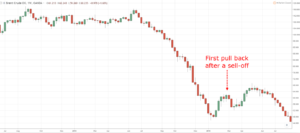
You’re probably wondering:
“Why do traders do this?”
Because of the fear of missing out (FOMO).
You don’t want to miss the next big move. Thus, you enter as soon as the markets show a sign of reversal. Unknowingly, this sign is usually a retracement of the existing trend.
And even if you catch the bottom in the markets, you’ll unlikely hold the trade for long.
Why?
Think about this…
Before this trade, you’d probably tried to catch market bottoms often. And while doing so, you’d have suffered multiple losses along the way, which hurts your psychology.
So when you finally see a base in the markets, you won’t hold the trade for long as you’ll experience the fear of losing (from your earlier works). This causes you to exit your transactions quickly, and you end up missing the big move.
Now, let’s move on…
The 4 stages of the markets and why it matters
Before identifying trend reversal, you must understand the 4 stages of the markets (a technique I learned from Stan Weinstein).
Why?
Because this gives you warnings that market conditions are about to change — which lets you plan trading decisions ahead of time.
The 4 stages of the markets can be broken down into:
- Accumulation stage
- Advancing stage
- Distribution stage
- Declining stage
Let me explain…
1. The accumulation stage
The accumulation phase looks like a range market in a downtrend. However, from an order flow perspective, the buyers and sellers are in equilibrium (that’s why the market is in a range instead of a trending market).
Generally in the accumulation stage:
- The ratio of bullish to bearish candles is close
- The 50-period moving average is flattening out
- The price whips back and forth around the 50-period moving average.
As time goes by, stops will gradually build up beyond the range as traders long near the lows and short near the highs of the range.
An example:
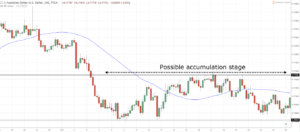
Now… there’s no guarantee that the market will reverse from here. But it should alert you to the possibility that the bears are weakening and the bulls could take control and push the price higher above the highs of the range.
And when this occurs, it leads us to the next phase…
2. The advancing stage
The advancing phase is an uptrend, with prices making higher highs and lows. From an order flow perspective, the buying pressure overwhelms the selling pressure (that’s why the market is trending higher).
Generally in the advancing stage:
- There are more bullish than bearish candles
- The bullish candles are more significant than the bearish candles
- The price is above the 50-period moving average
- The 50-period moving average is pointing higher.
An example:
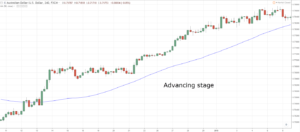
Now… the advancing stage eventually will need to “take a break” because the early buyers will take profits, and sellers will look to short the markets as prices are at attractive levels.
When this occurs, it leads us to the next phase…
3. The distribution stage
The distribution phase looks like a range market in an uptrend. However, from an order flow perspective, the buyers and sellers are in equilibrium (that’s why the market is in a range instead of a trending market).
Generally in the distribution stage:
- The ratio of bullish to bearish candles is close
- The 50-period moving average is flattening out
- The price whips back and forth around the 50-period moving average.
As time passes, stops will gradually build up beyond the range as traders long near the lows and short near the highs of the content.
An example:
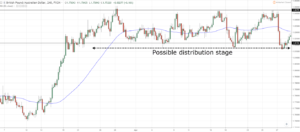
Now… there’s no guarantee that the market will reverse from here. But it should alert you to the possibility that the bulls are weakening and the bears could take control and push the price lower below the lows of the range.
4. The declining stage
The declining stage is a downtrend, with prices making lower highs and lows. From an order flow perspective, the selling pressure overwhelms the buying pressure (that’s why the market is trending lower).
Generally in the declining stage:
- There are more bearish than bullish candles
- The bearish candles are more significant than the bullish candles
- The price is below the 50-period moving average
- The 50-period moving average is pointing lower.
An example:
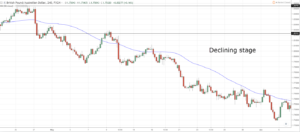
Now… the declining stage eventually will need to “take a break” because the early sellers will take profits, and buyers will look to long the markets as prices are at attractive levels.
When this occurs, it leads us back to the accumulation phase.
How to identify trend reversal like a pro
“But Rayner, how do you know if the market will break higher off the accumulation stage and not just continue trading lower?”
That’s a great question.
The secret is this…
You want to identify an accumulation stage that leans against the Support on the higher timeframe.
Here’s how to do it:
- Identify Support on the higher timeframe (e.g. Daily)
- Identify an accumulation stage on the lower timeframe (e.g. 1 hour).
Let me explain…
1. Identify Support on the higher timeframe (Daily)
Look at the market to approach Support on the Daily timeframe; the more significant the level, the better.
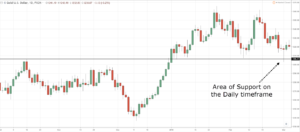
2. Identify an accumulation stage on the lower timeframe (1-hour)
Then, go down to the lower timeframe and identify an accumulation stage. This means the market is ranging after being in a downtrend. An important thing is for the lows of the accumulation stage to lean against Support on the higher timeframe.
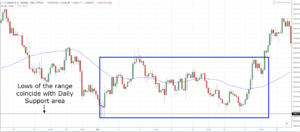
As a general guideline:
If you identify Support on the Daily timeframe, you can locate an accumulation stage on the 1 to 4-hour timeframe.
Or, if Support is on the Weekly timeframe, then you can identify an accumulation stage on the 4-hour to Daily timeframe.
The trend reversal trading setup
Now, there are 3 ways you can trade this setup:
- Support & Resistance
- The Breakout
- The Pullback.
Assuming you’re using the Daily and 1-hour timeframe combination, these setups will be found anywhere between the 1 to 4-hour timeframe.
Let me explain…
1. Support & Resistance
If you haven’t realized by now, the low of an accumulation stage is an area of Support (plus it’s leaning against the higher timeframe Support). So, if you’re expecting higher prices, won’t going long in this area make sense?
Here’s what I mean…
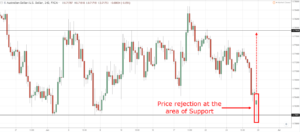
Pros: This setup offers a favourable risk to reward as you enter the move’s earliest stage. Imagine your potential reward if the market breaks out of the accumulation stage.
Cons: The price may not re-test Support, thus not giving you an entry signal.
2. The Breakout
Alternatively, you can wait for the price to break out higher and then enter the trade.
An example:
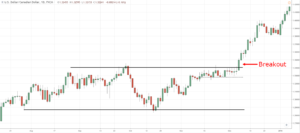
Pros: You will catch every move as the market transitions from an accumulation stage to an advancing stage.
Cons: It could lead to a false breakout.
3. The Pullback
Lastly… you can wait for the pullback before entering the trade. For example, when the price retraces to the previous Resistance, it turns Support and forms a bullish reversal candlestick pattern. Here’s what I mean:
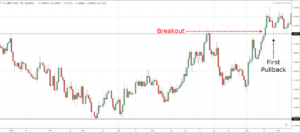
Pros: This setup offers a favourable risk to reward as you enter an area of value (previous Resistance turned Support).
Cons: The pullback might never come, and you risk missing the move.
